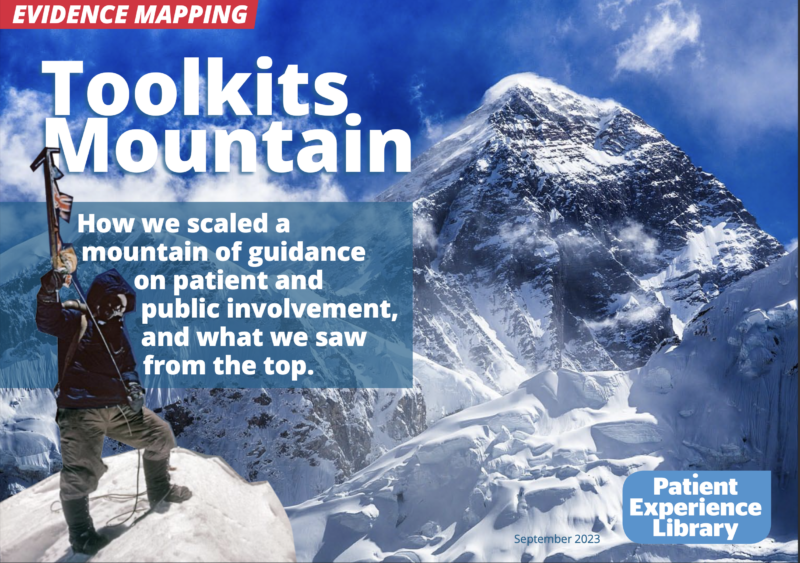Bringing focus to the study of patient experience
The UK produces a wealth of information about patient experience, such as research and reports published by government bodies, health charities, patient voice organisations, and academic institutions.
This body of information is essential to helping us understand what works – and what doesn’t – in health care from the point of view of patients.
At present, there is no system of prioritisation for research into patient experience. Researchers and research funders don’t know which areas of patient experience are most in need of further study, or where there is duplication or overlap.
Without a structured overview of the current patient experience evidence base, we cannot form a clear picture of what information we need to be collecting from which demographic groups.
Our vision was to create an online tool that would make information about patient experience easy to find in one location.
With this in mind, we set ourselves three main aims for our project:
- Map selected areas of the patient experience evidence base, exposing saturation and gaps, and showing who gets heard, and who doesn’t.
- Create open access online maps, enabling researchers, policymakers and patient advocates to explore the data for themselves.
- Lay the foundations for good prioritisation processes in patient experience research, to end the current free-for-all.
We wanted to enable rigorous, high quality research into patient experience and lay the ground for an informed approach to setting priorities for this area.
Building our first evidence map
Our initial focus was to test our approach by putting together an evidence map of patient and public involvement (PPI) guidance, something that had never been done before in the UK.
During this phase of the project, we created a template designed to give busy professionals an overview of the findings they needed easily and quickly.
We also developed interactive visual tools to allow users to view and manipulate data and download source documents.

PPI guidance: a crowded field
The exercise of pulling together the first evidence map on PPI was itself a learning experience. One thing we learned was that there is a large volume of guidance being produced.
We unearthed 536 examples of PPI frameworks, and discovered that in the ten-year period from 2012 to 2022, a new PPI toolkit was coming out on average every two weeks.
The rate does not seem to be slowing: in the few months since we completed our analysis, a further 22 PPI toolkits have been published.
Capturing these toolkits into an evidence map is one of the ways in which we hope to build organisational memory and reduce duplication. Rather than having to start from scratch, anyone who needs PPI guidance can search the library for the guidance that suits them best.
Raising the voices of seldom heard groups
Aside from the sheer volume of PPI guidance being published, one of the more striking findings of this exercise was how common the terms “hard to reach”, “seldom heard” and “underserved” appeared.
But while these terms were commonly used, most of the guidance we found was generic.
We found 127 examples of guidance on involvement for the general population, but just 16 examples for specific underserved groups.
Having a clear picture of the types of PPI guidance that are available to different groups across the health and care service allows us to invest PPI resources where they are most needed. This is just one example of how open access evidence maps can be used as a tool to tackle health inequality across the UK.
Using qualitative analysis and categorisation
After setting up the PPI evidence map, we then created evidence maps for the patient experiences of COVID-19 and digital health care. Further maps are in the pipeline.
Creating the maps means first of all manually reading thousands of reports, and then developing coding frameworks to aid thematic analysis. The COVID-19 evidence map, for example, covers topics such as experience of lockdowns, attitudes to vaccines, care home visiting bans, and more.
For our analysis, we had to apply a degree of professional judgement, opening up the possibility that others might have applied different judgements. This makes our interactive visualisations a vital component of the process as they allow users to dive deeper into the data and, if desired, to draw their own conclusions.
The challenge: data-driven visualisation
Creating a visualisation tool has been one of the most challenging and informing areas of our project. Investing considerable time and highly skilled expertise has enabled us to create a sophisticated management information system.
Even more challenging was the task of presenting the system as an online tool that was free and simple to use without training or specialist knowledge. We wanted anyone to be able to use it on any device, without the need for an app or an update. We are delighted to have achieved our goal.
Open access patient experience evidence: it can be done
Our work has demonstrated that mapping the patient experience evidence base is entirely feasible.
The maps we have created will be open to everyone. This will enable others to share in the learning that we have developed over the last year.
With an open access evidence base in place, those involved in PPI research can now develop proper prioritisation processes for this vital field of research.
Apart from reducing duplication and waste, that could also ensure that those “seldom heard” voices can be accurately targeted in future.
Find out more
Visit the Patient Experience Library.
Watch an online demo of how we built an evidence map.
If you want to keep up to date with our project, follow us on @patientlibrary on social media or get in touch.